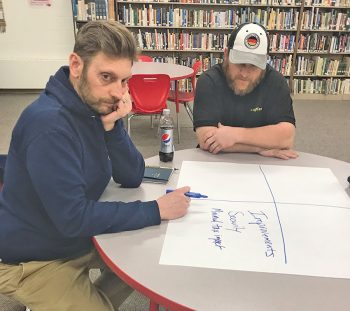
Photo by Wanda Hanson
Andy Fields from SiteLogiQ started out the special workshopping session February 9 by asking the Houston School Board four questions. To answer the questions, the board was asked to split up in teams and write their answers on large posters before regrouping to discuss their responses.
The first question was, “What do you see as the ultimate goal of your referendum?” The board listed three goals: providing as much as possible for the students, increasing security particularly at the elementary, and being fiscally responsible.
Question two asked what stood out to them from the survey of the public. Responses included: the fact that safety was a top priority, the great support of the school, and the public perspective of the school facilities versus updates that are needed at the school.
The third question was “What stood out on the financial presentation by Ryan Fetters of Baker Tilly?” The board responded by asking for a better breakdown of the tax impact for residents as well as how the calculations worked for ag credits for farmers. They also noted that a stretch in the amount did not affect the taxes as much as they thought it might. The board was cognizant that they might not be able to afford all the projects they wanted.
The final question asked for any other questions they had. The biggest questions continued to be regarding the tax impact and the ag credits for farm land.
SiteLogiQ next presented the projects with their costs. They pointed out that some things had to be done in conjunction with others in order to follow the current guidelines on health and safety and accessibility.
Fields told the board that the median home in the school district is valued at $138,000. If a $20 million referendum for 20 years were to be passed, the tax impact would be $273 annually or $22.75 monthly. A $150,000 homestead would pay an additional $303 annually ($25.25 monthly); a $200,000 homestead would pay an additional $433 annually ($36 monthly).
The board next looked at three scenarios, each costing around $20 million, that had been prepared by SiteLogiQ. While none of them suited the board, they did lead the board to begin proposing other combinations. The board noted it helped them to know each project’s price as they prioritized projects.
Secure entries at both buildings, an elevator and new cafeteria at the elementary, as well as high school projects such as an auditorium, a new weight room, new locker rooms, additional CTE classrooms, flexible learning spaces, a new cafeteria, and additional parking were all considered as possibilities.
After three hours of workshopping and discussion, the board did not feel ready to make a firm decision. Secure entries at both schools as well as an elevator and a new cafeteria at the elementary were seen as top priority, but board members disagreed on other high school project priorities.
Any addition to the high school would need to include ADA work with a $4.2 million price tag. CTE classrooms and flexible learning spaces were seen as a priority at the high school. Some members of the board wanted to include an auditorium, while others felt different projects were needed more as they struggled to get the best value. The possibility of reducing the size of an auditorium or making it more flexible with movable seating so it could be used for other purposes was suggested.
The board was not able to reach a consensus. They still wanted to see more details regarding the impact on ag land taxes and other financial information. The board felt it would be too rushed to put a referendum vote on a special election in early May. Instead, the board opted to have another workshopping session on March 16 and work toward a goal of an August referendum vote. With a positive August vote, the construction timeline would be the same as if the vote was in May.
Fields encouraged the board members to consider the projects until the next workshopping meeting and ask themselves what will give them the best chance of getting the referendum approved.

Leave a Reply